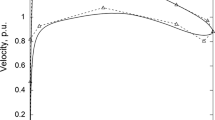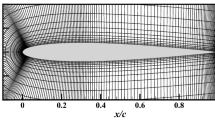Abstract
In this paper, we consider an optimization problem for the complete design chain of an airfoil. Starting with a parameter vector, one has to perform a three step procedure to evaluate the desired objective: Generate a grid around the airfoil, compute the flow around the airfoil, and compute the objective. Applying a gradient-based optimization method, one has to provide derivatives for this complex process. In the present paper, we propose the advanced use of automatic differentiation to compute the required gradient information. We report numerical results together with a mesh independency study and an analysis of the optimization process for an inviscid RAE2822 airfoil under transonic flight conditions.











Similar content being viewed by others
References
Barttfeld M, Alleborn N, Durst F (2006) Dynamic optimization of multiple-zone air impingement drying processes. Comput Chem Eng 30:467–489
Biegler LT, Zavala VM (2009) Large-scale nonlinear programming using IPOPT: An integrating framework for enterprise-wide dynamic optimization. Comput Chem Eng 33:575–582
Bücker M, Corliss G, Hovland P, Norris B, Naumann U (eds) (2005) Automatic differentiation: applications, theory, and tools. Springer, Berlin
Christianson B (1994) Reverse accumulation and attractive fixed points. Optim Methods Softw 3:311–326
Corliss G, Faure C, Griewank A, Hascoët L, Naumann U (eds) (2001) Automatic differentiation: from simulation to optimization. Springer, New York
Giering R, Kaminski T (1998) Recipes for adjoint code construction. ACM Trans Math Softw 24:437–474
Griewank A, Walther A (2008) Evaluating derivatives: principles and techniques of algorithmic differentiation. SIAM, Philadelphia
Griewank A, Juedes D, Utke J (1996) ADOL-C: a package for the automatic differentiation of algorithms written in C/C++. ACM Trans Math Softw 22:131–167
Hascoët L, Pascual V (2004) Tapenade 2.1 user’s guide. Technical report 300, INRIA
Heinrich R (2006) Implementation and usage of structured algorithms within an unstructured CFD-code. Notes on numerical fluid mechanics and multidisciplinary design, vol 92
Hounjet MHL, Prananta BB, Zwaan R (1995) A thin layer Navier-Stokes solver and its application for aeroelastic analysis of an airfoil in transonic flow. In: Proceedings international forum on aeroelasticity and structural dynamics, pp 1.1–1.9
Jameson A (1988) Aerodynamic design via control theory. J Sci Comput 3(3):233–261
Jameson A, Reuther J (1994) Control theory based on airfoil design using the Euler equations. In: AIAA proceedings 94-4272-CP
Jameson A, Martinelli L, Pierce NA (1998) Optimum aerodynamic design using the Navier-Stokes equations. Theor Comput Fluid Dyn 10(1–4):213–237
Kroll N, Gerhold Th et al. (2001) Parallel large scale computations for aerodynamic aircraft design with the German CFD system MEGAFLOW. In: Proceedings of ‘Parallel CFD 2001’, Egmond aan Zee
Kroll N, Rossow CC, Becker K, Thiele F (2000) The MEGAFLOW project. Aerosp Sci Technol 4:223–237
Oyama A, Liou M-S, Obayashi S (2004) Transonic axial-flow blade optimization: Evolutionary algorithms/three-dimensional Navier-Stoke solver. J Propuls Power 20(4):612–619
Periaux J, Deconinck H (eds) (2006) Introduction to optimization and multidisciplinary design. Lecture series, vol. 2006-03. von Karman Institute for Fluid Dynamics, Sint-Genesius-Rode. ISBN 2-930389-65-6
Rossow C-C (2000) A flux splitting scheme for compressible and incompressible flows. J Comput Phys 164:104–122
Schlenkrich S, Walther A, Gauger NR, Heinrich R (2008) Differentiating fixed point iterations with ADOL-C: Gradient calculation for fluid dynamics. In: Bock HG, Kostina E, Phu HX, Rannacher R (eds) Modeling, simulation and optimization of complex processes—proceedings of the third international conference on high performance scientific computing 2006, pp 499–508
Swanson RC, Turkel E (1997) Multistage scheme with multigrid for Euler and Navier-Stokes equations (components and analysis). Technical Report 3631, NASA
Wächter A, Biegler L (2006) On the implementation of an interior-point filter line-search algorithm for large-scale nonlinear programming. Math Program 106(1):25–57
Wang JF, Periaux J, Sefrioui M (2002) Parallel evolutionary algorithms for optimization problems in aerospace engineering. J Comput Appl Math 149(1):155–169
Widhalm M, Rossow C-C (2004) Improvement of upwind schemes with the least square method in the DLR TAU code. Notes Numer Fluid Mech 87
Acknowledgement
The authors gratefully acknowledge the support of the DFG Priority Program 1253 entitled Optimization with Partial Differential Equations.
Author information
Authors and Affiliations
Corresponding author
Rights and permissions
About this article
Cite this article
Gauger, N., Walther, A., Özkaya, E. et al. Efficient aerodynamic shape optimization by structure exploitation. Optim Eng 13, 563–578 (2012). https://doi.org/10.1007/s11081-011-9184-9
Received:
Accepted:
Published:
Issue Date:
DOI: https://doi.org/10.1007/s11081-011-9184-9




